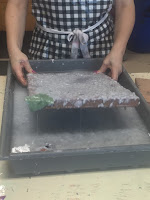"Hands On" Evaluation
Through this project, I was looks into elements and principles of
design. To help me keep in track with all the definition, we were giving a task
to create 14 glossary pages using different materials and techniques within
each glossary page. Sometime I would also need to get my ideas from secondary
resources such as artist or Pinterest, which I used to find more techniques
from Pinterest but I'm also using primary resources such as taking
photo of my own hand, family or families. Using all the techniques and
materials to match the meaning of each in elements and principles, I came to
realise what kind of affect each piece has. For example Proration and rhythm,
even though I'm using a same material but there different
because rhythm is about movement and proration is about scaling so they would
have different meaning and techniques within each piece.
During the each workshop, I was looks and learns new stuffs in the
workshop and even though some of them I may already have known, yet I still
learning quite few in the each workshop. Such as in Photography, this is my
first time learning about photography and it was quite difficult but in the
end, I understand most basic and how camera can be affected the photo and
different settles with different angle can also change style of the images.
Next workshop was ceramic, even though I already know what to do in this
workshop but I still haven’t learn quite a few stuffs about how to made an
sculpture without them falling apart and the tutor was taught me how to remove the
airs from clay, which it was really helpful because she also explaining the
reason why we have to removes the airs from the clay, it may make the sculpture
explored after it got burn but the most important things that I thought it was
quite useful was improving my solving problem skills because I have to make
sure the sculpture doesn’t fall and actually stick each parts together. 3D
woodwork taught me how to plan my work out and thinks about the next step
before do it. Print-making taught me the key term with meaning and what’s chine
colle. Another thing is, it help me remembering that I should just keep my
imaginations open wild because with zentangle, I need to have my open to create
a patterns from my head. I already know about ow to screen printing and
batik but what I learned about textile was how to heat transfer, puff binder
and paper making and embroidery. How puff binder and screen printing is quite
amazing together when become one and heat transfer was really great even though
I have to be careful while using it but totally worth learning it.
Even with all those things that I have learned, I still have a
lots to improve, such as my time management, organisation and being creative.
The reason why I think I have problem with those skills, is because at first,
I couldn't manages get everything done in time, even though done
all my blog, 10 pages on my sketchbook and everything completed in the workshop
but doing 20 glossary pages was taking too much times, it wasn't really
worth it because the quality wasn’t in the excellent standard, next time I
will improves it and write what need to be done in each week. I’m having quite
a lots of problem with being creatives even though I mostly using my own ideas
to create my artwork but after looks into other people works in Pinterest, I
always wanting to change my ideas because they got a better quality work than I
do, which causing me to have trouble with making my own decision but I still
enjoy doing it, even though it wasn’t great like an artist but I been taught
different things in each workshops and explored the materials with different
techniques.












































